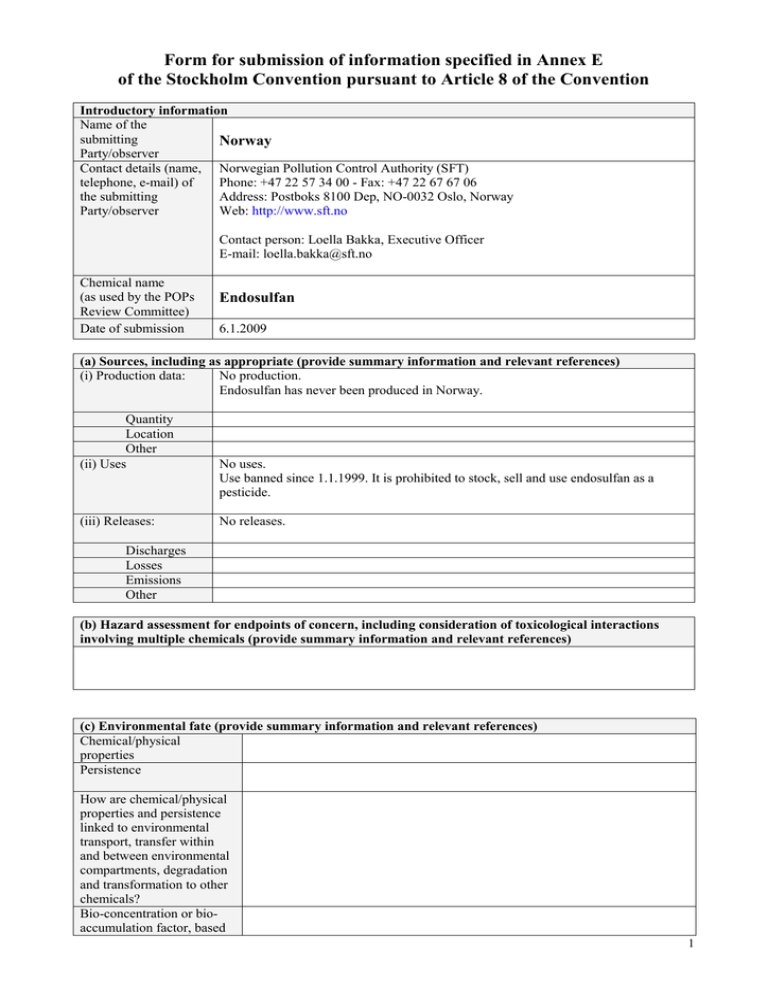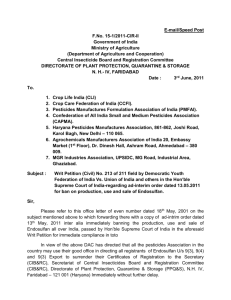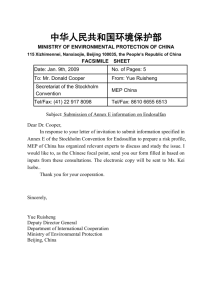Form for submission of information specified in Annex E
advertisement

Form for submission of information specified in Annex E of the Stockholm Convention pursuant to Article 8 of the Convention Introductory information Name of the submitting Norway Party/observer Contact details (name, Norwegian Pollution Control Authority (SFT) telephone, e-mail) of Phone: +47 22 57 34 00 - Fax: +47 22 67 67 06 the submitting Address: Postboks 8100 Dep, NO-0032 Oslo, Norway Party/observer Web: http://www.sft.no Contact person: Loella Bakka, Executive Officer E-mail: loella.bakka@sft.no Chemical name (as used by the POPs Review Committee) Date of submission Endosulfan 6.1.2009 (a) Sources, including as appropriate (provide summary information and relevant references) (i) Production data: No production. Endosulfan has never been produced in Norway. Quantity Location Other (ii) Uses (iii) Releases: No uses. Use banned since 1.1.1999. It is prohibited to stock, sell and use endosulfan as a pesticide. No releases. Discharges Losses Emissions Other (b) Hazard assessment for endpoints of concern, including consideration of toxicological interactions involving multiple chemicals (provide summary information and relevant references) (c) Environmental fate (provide summary information and relevant references) Chemical/physical properties Persistence How are chemical/physical properties and persistence linked to environmental transport, transfer within and between environmental compartments, degradation and transformation to other chemicals? Bio-concentration or bioaccumulation factor, based 1 on measured values (unless monitoring data are judged to meet this need) (d) Monitoring data (provide summary information and relevant references) Measurement of Endosulfan, Dieldrin and Endrin in Norwegian air and sediment samples (SFT, 2007) Endosulfan is not a part of the existing environmental monitoring network in Norway. To get an indication of the background concentration levels and long range atmospheric transport potential, concentrations of endosulfan were measured in air samples from Birkenes and Ny-Ålesund and in marine fresh water sediment samples from 16 sampling stations distributed all over Norway. Birkenes is located in southern Norway, to the south east of the Scandinavian mountain chain. Due to the location of the site away from local pollution sources, long range transport exerts a large influence on the pollution climatology of the site. The Zeppelin station close to Ny-Ålesund, Spitsbergen, is located in an undisturbed Arctic environment. The Zeppelin mountain is an excellent site for atmospheric monitoring and experience minimal contamination from the local settlement due to its location above the inversion layer. Air samples For all air samples atmospheric trajectories were calculated in order to assess the origin of the air mass and the air contaminants. The concentrations of endosulfan-I (α-isomere) measured in air samples from Birkenes were in the range of 3,4 to 25 pg/m3. Endosulfan-II (β-isomere) was below the detection limit. The concentration of endosulfan-I measured in air samples from Ny-Ålesund were in the range of 5,2 to 13,2 pg/m3. The concentrations of endosulfan measured at both sites were in the same range as found in samples from other rural or Arctic sites not influenced by recent use of endosulfan. Since there is no historical data on endosulfan from Birkenes or Ny-Ålesund, it is not possible to calculate a temporal trend. However, it seems apparent from the data from the arctic stations Alert and Tagish (Canada) in the early 1990s, that there is no substantial decrease in the Arctic levels. The results from this study also show significantly higher concentrations for periods with trajectories from potential source regions (Western and Eastern Europe) compared with periods with trajectories form other areas (British Isles and Arctic). Both the fact that measurable concentrations of endosulfan-I were found at Birkenes and Ny-Ålesund and the correlation of the concentrations with origin of the air masses are strong indicators for airborne long-range transport of endosulfan. Sediment samples Endosulfan-I, endosulfan-II and endosulfan sulphate was not detected in sediment samples from Norway. Reference: SFT, 2007. Measurement of Endosulfan, Dieldrin and Endrin in Norwegian air and sediment samples, Norwegian Pollution Control Authority, Report 976/2007. Norwegian soil and water monitoring in agriculture - JOVA This is a national monitoring program for catchment areas dominated by agriculture. Parts of this program were established in 1992, but the monitoring program for pesticides started in 1995. The main activity is monitoring of streams and rivers, but there is also some monitoring of drinking water wells, ground water, precipitation and sediment. The main purpose of the pesticide monitoring program is to follow the occurrence and trends of pesticides in aquatic environments associated with agriculture. The monitoring data can also be use to assess the effects of restrictions, limitations and bans of different pesticides. Endosulfan has been included this program since the beginning, but has not been detected in any of the studies. This can probably be explained by the fact that endosulfan has not been widely used in Norway and the fact that it was banned already in 1999. References: Monitoring of pesticides in streams and rivers. Annual report 2006. Ludvigsen, G.H. and Lode, O., 2008. Bioforsk report Vol. 3:33 2008. (Only in Norwegian). Overview of detected pesticides during the period 1995-2006. Ludvigsen, G.H. and Lode, O., 2008. Bioforsk report Vol. 3:14 2008. (Only in Norwegian). Loss of pesticides from agricultural areas - development over time. Ludvigsen, G.H. and Lode, O., 2005. Jordforsk report 97/05. (Only in Norwegian). 2 (e) Exposure in local areas (provide summary information and relevant references) General As a result of long-range environmental transport See report SFT, 2007 in d) above. Information regarding bioavailability (f) National and international risk evaluations, assessments or profiles and labelling information and hazard classifications, as available (provide summary information and relevant references) Water framework directive – priority list of substances Endosulfan is on the priority list of substances under the water framework directive and is identified as priority hazardous substance (COM (2006) 397 final). Such substances are of particular concern for the inland, transitional, coastal and territorial waters and will be subject to cessation or phasing out within an appropriate timetable that shall not exceed 20 years (decision 2455/2001/EC). (g) Status of the chemical under international conventions ___________________________ 3

